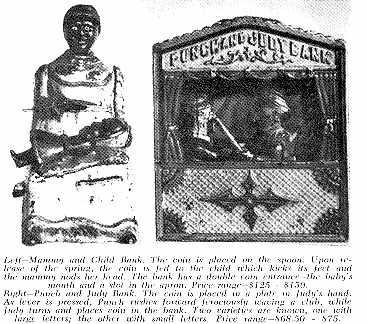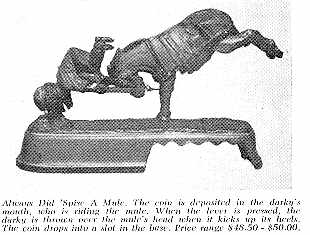THE ANTIQUES JOURNAL, September, 1961
Mechanical Banks
A Survey
M
ECHANICAL BANK COLLECTING BEGAN about forty years ago. At that time there were but a handful of people interested in their accumulation. Interest increased rapidly until now there are thousands who avidly seek to gather these vanishing items of youthful thrift. The banks were manufactured by various companies, from the 1880’s
through the early 1900’s. One of the prominent producers was the J. & E. Stevens
Company, Cromwell, Connecticut. The firm issued many of the well-known varieties such as:
The Owl Bank, Jolly Nigger Bank, Bad Accident Bank, Speaking Dog Bank, Kicking Mule Bank,
William Tell Bank, Bill E. Grin, Teddy and the Bear Bank and others.
The banks were manufactured by various companies, from the 1880’s
through the early 1900’s. One of the prominent producers was the J. & E. Stevens
Company, Cromwell, Connecticut. The firm issued many of the well-known varieties such as:
The Owl Bank, Jolly Nigger Bank, Bad Accident Bank, Speaking Dog Bank, Kicking Mule Bank,
William Tell Bank, Bill E. Grin, Teddy and the Bear Bank and others.
The most avid collectors are members of the banking profession. The association of mechanical banks to the banking business, where money is saved, is apparently the connecting link which endears the penny-savers to the bankers. The competition has been keen for these midget saving machines.
Bankers are not the only collectors for these cast iron money depositories. Doctors, lawyers, auto mechanics, firemen, postal clerks, business men and even a garbage man is reported to have a collection. Collectors with special interests also seek mechanical banks. A circus enthusiast will be interested in the various elephant banks or in one of the clown banks. A bird lover would have an interest in the Owl Bank and the Eagle and Eaglets Bank. Sports devotee could be a collector for the Baseball Bank and Calamity or Football Players Bank. The list could be increased because of the numerous types of banks which were manufactured in the era when thrift was the philosophy of the day.
 Mechanical bank manufactures, during the period c. 1882 to 1895, packed their
brightly painted penny banks in wooden boxes or other containers. The identifying name was
stamped on the side, such as — Humpty Dumpty, Hold The Fort, Bill E. Grin, Always Did
’Spise A Mule, and others. These fascinating and intriguing toys, planned for the
teaching of thrift, were shipped to city and country stores throughout the nation. In
those days when the dollar was sound and worth its full value, the price range from 95c to
$2.50 was considered rather steep.
Mechanical bank manufactures, during the period c. 1882 to 1895, packed their
brightly painted penny banks in wooden boxes or other containers. The identifying name was
stamped on the side, such as — Humpty Dumpty, Hold The Fort, Bill E. Grin, Always Did
’Spise A Mule, and others. These fascinating and intriguing toys, planned for the
teaching of thrift, were shipped to city and country stores throughout the nation. In
those days when the dollar was sound and worth its full value, the price range from 95c to
$2.50 was considered rather steep.
Cents in the early bank days were often hard to come by and were not often available for saving, so some stores found their toys to be very slow movers. Gradually many of them were shoved to the back of the shelf or put out of sight and forgotten. This made it possible for early collectors to buy penny banks in new condition.
Serious collectors prefer to have banks with original paint. A repainted one will often bring less than one which has a dull, shabby appearance but still retains its first paint. Collectors also set the same standard for banks with parts which have been replaced. Often, one of the rare banks will have more value with a part broken or missing than the same bank, which has been partially reconstructed. Some collectors are of the opinion that redecorated or rebuilt banks have no place in a collection because such items destroy the beauty and value of genuine old banks.
In the early days of collecting, prices were naturally much lower than today’s values. Years ago, a collector could occasionally find a bank in a country store and buy it at its original price, possibly a dollar or two, but those days are now gone. Once in a while an antique dealer can uncover a mechanical bank in an attic and buy it cheap but these occasions are becoming few and far between.
The value of any commodity is determined by the law of supply and demand. Today, mechanical banks are at a high price level because the supply is running short. For example, the Jumbo Bank sold for 95c, now it is valued at approximately $100.00, or more. Such instances are numerous.
A small number of reproductions have recently appeared on the scene and this has caused some confusion momentarily and a temporary drop in prices of the copied models. However, the collector who uses caution and takes time to gain knowledge of his field will be able to build an authentic collection.
The outlook for collecting mechanical banks in the future is bright. As time passes, the old banks become scarcer. In these days of inflation an investment in these penny-savers should show a profit in the coming years. The past has proven the fact.
